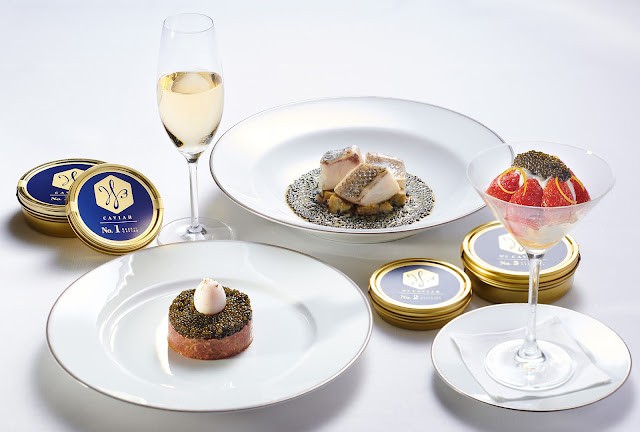`Caviar’ you may state, with a quizzical look and twitched raised eyebrows, is a matter of discerning taste. Vegans will frown upon it, and mouth some hell vibe, because the sturgeon fish (from where some of the rarest and most expensive roe originates) is an endangered hunted animal. So, when my friend, celebrity Chef James Won – the first and only Malaysian to be inducted into the exclusive Krug Ambassade Network. He is also a Chevalier, a Knight by the Ordre des Coteaux de Champagne – had a Caspian Caviar tasting session at his METTA office in Malaysia (some new F&B super brands to be launched in January 2022, and you’ll hear it from me first), I couldn’t resist.
For a little rewind into history, Caviar (also known as caviare; from Persian), is a food consisting of salt-cured roe of the family fish species called Acipenseridae. Sturgeon is the common name for the 27 species of fish belonging to this family tree. The earliest sturgeon fossils date to the Late Cretaceous, and are descended from other earlier acipenseriform fish who date back to the Triassic period some 245 to 208 million years ago.
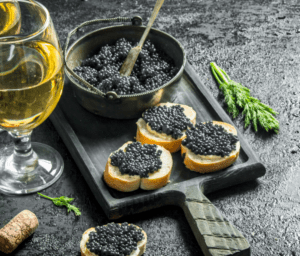
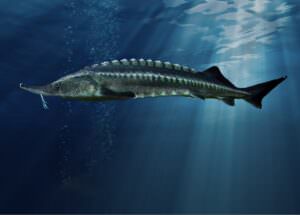
The Caspian Sea – the largest inland body of water in the world, and the largest salt-water lake on Earth – is home to the rarest and prized sturgeon fish. Created some 5.5 million years ago when it was cut off from the Tethys Ocean due to shifting of tectonic plates, many of the world’s sturgeon species, having not evolved or changed much since their time living with the dinosaurs, followed the flowing rivers to find a new home in the Caspian. With no natural outflow other than by evaporation, the sturgeon have stayed and thrived in the waters of the Caspian for as long as any other marine life.
Here’s another fascinating input. Sturgeons are long-lived, late maturing fish species with an average lifespan of 50 to 60 years. Their first spawn does not occur until they are around 15 to 20 years old. Known to be `broadcast spawners,’ (release their gametes (sperm and eggs) into open water for external fertilisation), sturgeons do not spawn every year, because they require specific environmental conditions which may or may not be met each year. When all conditions are a go, a single female may release 100,000 to 3 million eggs at one time.
By the time humans living around the areas of the Caspian learnt to harvest this prized catch, Caviar and sturgeon from the Sea of Azov began reaching the tables of aristocratic and noble Greeks in the 10th century, after the commencement of large-scale trading between the Byzantine Empire and Kievan Rus.

Back to present, I stood by Chef Won’s table in a veil of silent awe. In front of me lay the world’s most expensive containers of Almas, Sevruga, Beluga, and Baeri Caviar. Nothing short of approx.US$ 25,000 worth of luxury I was going to snack on a balmy mid-noon weekday. Talk about the perks of my work!! A shudder of pleasure running down my back, the taste of each spoon of caviar meeting my lips and tongue, exploding in anticipation. You have to hold it, savour it, feel the roe on the roof of your mouth as flavours burst like twinkling stars on a night sky. If you have a sensitive stomach, even the gastric walls notice a change in delirious body temperature. As I went through each caviar jar absorbing its aromatic notes and feeling its luxurious sensations, I went gliding, as on air, totally understanding why the world of luxury was in a hot fix.
Let me explain.
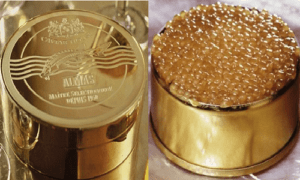
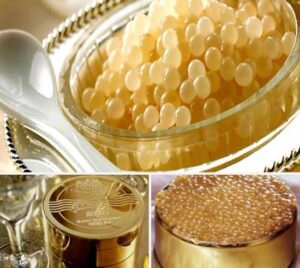
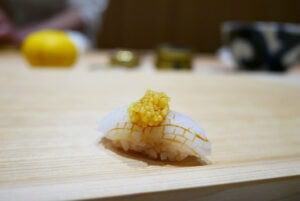
Almas Caviar – Worth its weight in Gold
In Russian, Almas means diamond. The most expensive and most exclusive type of caviar, Almas Caviar has been enjoyed as a delicacy as far as the ancient Greeks who imported it from the area now known as Crimea in the southern Ukraine. According to the Guinness Book of World Records, Almas caviar is sold for US $34,500 for 1kg, making it the most expensive food in the world.
What is it about Almas caviar that makes it so costly? There are a few factors. Almas caviar comes exclusively from the very rare albino beluga sturgeon that are more than 100 years old, and live mostly on the Iranian side of the Caspian Sea. Their eggs are white and smooth with a spongier texture. The Almas’ nuanced flavour profile is achieved through delicate salting which draws the caviar’s distinctive nutty, yet creamy taste. Bliss!
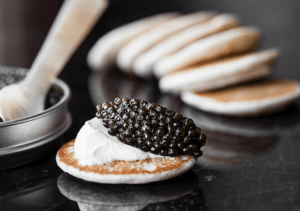
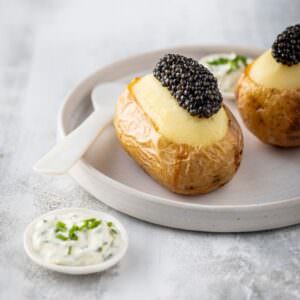
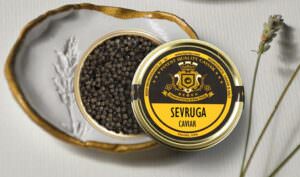
Sévruga Caviar – A Starry Sturgeon
The Stellate sturgeon, also known as the starry sturgeon, is native to the Aegean, Azov, Black and Caspian Seas, and reproduces more quickly in comparison to its other cousin species. Although its eggs are smaller, its compact but loaded roe with flavour makes it the most famous throughout the world. As a result, Sévruga Caviar is one of the highest priced varieties of caviar, the most available, and the least expensive, standing out with a prominent marine flavour, followed by a more delicate nutty, creamy notes and texture.
In 2018, Sevruga Caviar accounted for approx. 25% of global revenue. In recent years, sevruga caviar has become widely prevalent in the market and is readily consumed by beginner connoisseurs. A Privé Sevruga Caviar from Iran costs €2,870 per 1000 gram.
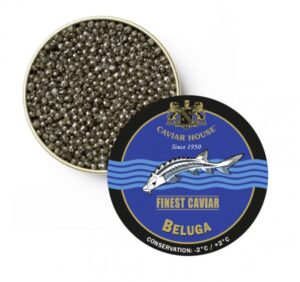
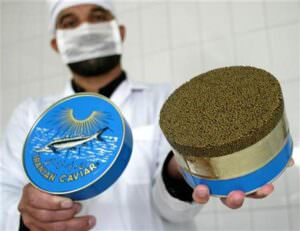
Beluga Caviar – Hello Huso Huso Sturgeon
The famed caviar from the huso huso sturgeon, Beluga caviar has forever been synonymous with epicurean luxury, always sought after by chefs and connoisseurs, the food of royalty and movie stars. As the second to Almas most costly and common type of caviar, Beluga caviar is still relatively rare and was known to be reserved for prominent royal families in the past.
The unrestrained appetite for this caviar took its toll on this once-plentiful ancient fish native to the Caspian Sea, and Beluga was finally fished to the point of extinction. The result was that in 2005, the United States Fish and Wildlife Services banned the sale of Beluga caviar to allow Beluga populations to recover and to save the fish from extermination- the sale is still prohibited. While there have been efforts to farm-raise Beluga sustainably, the slow growth of this fish makes it a painstaking endeavour, and caviar aficionados have had to look elsewhere for their Beluga fix.
Beluga caviar has the largest individual eggs of all caviar. Each orb can be as large as a pea and ranges in colour from a pale-silver or gray to a dark, inky black. The flavour is a balanced buttery saltiness and is best enjoyed with minimal, simple accompaniments (such as on blini or toast points), rather than anything else that may distract from the delicate flavour of the caviar itself.
Beluga caviar is the second most expensive type of caviar with present market prices ranging from $7,000 to $10,000 per 1 kg.
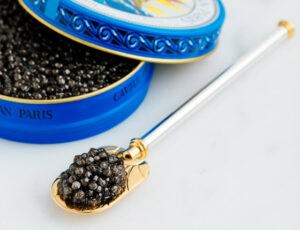
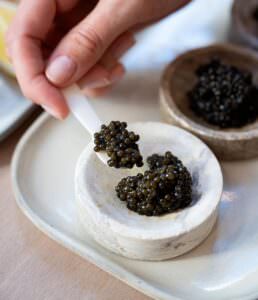
Baeri Caviar – Beginner’s Luck
Baeri eggs are both firm-textured and fragile at the same time, and is one of the most famous caviars that allows its subtlety to be appreciated by those who are newcomers, as also connoisseurs.
Produced in the very best farms in the world, Baeri originated in Siberian waters. Its adaptability has meant that producers farming Acipenser Baerii sturgeons are among the best-known in the world.
A delicate colour mix of greys and chestnut lights, once in the mouth the little grains of Baeri Caviar release delicate woody notes associated with a subtle hazelnut flavour. Served either as an appetizer or an aperitif, Baeri caviar is reference greatly in French cuisine, and is sold at $2,500 per 1 kg.
So, do you feel like a pro now? We’ve only just begun. As the weather turns for happier days, and restaurants echo back with happy laughter, here’s wishing you happy spooning too. After all, no seduction ever went wrong in the company of Caviar. Let’s pop that Champagne to love and magic.
Stay magical!
*
*
Photo images from Google
The above article was published in the OHerald Cafe on October 26, 2021.
FOLLOW me on IG https://www.instagram.com/etheldacosta/
